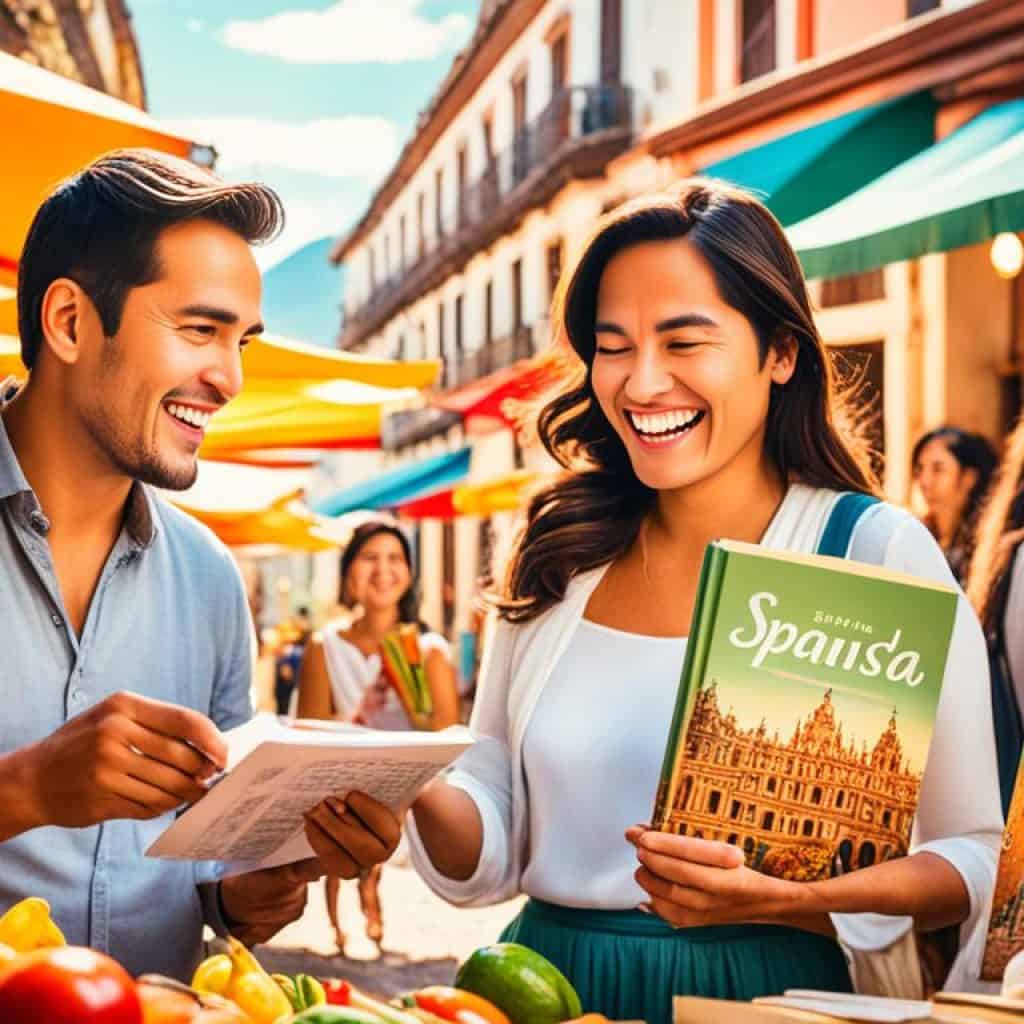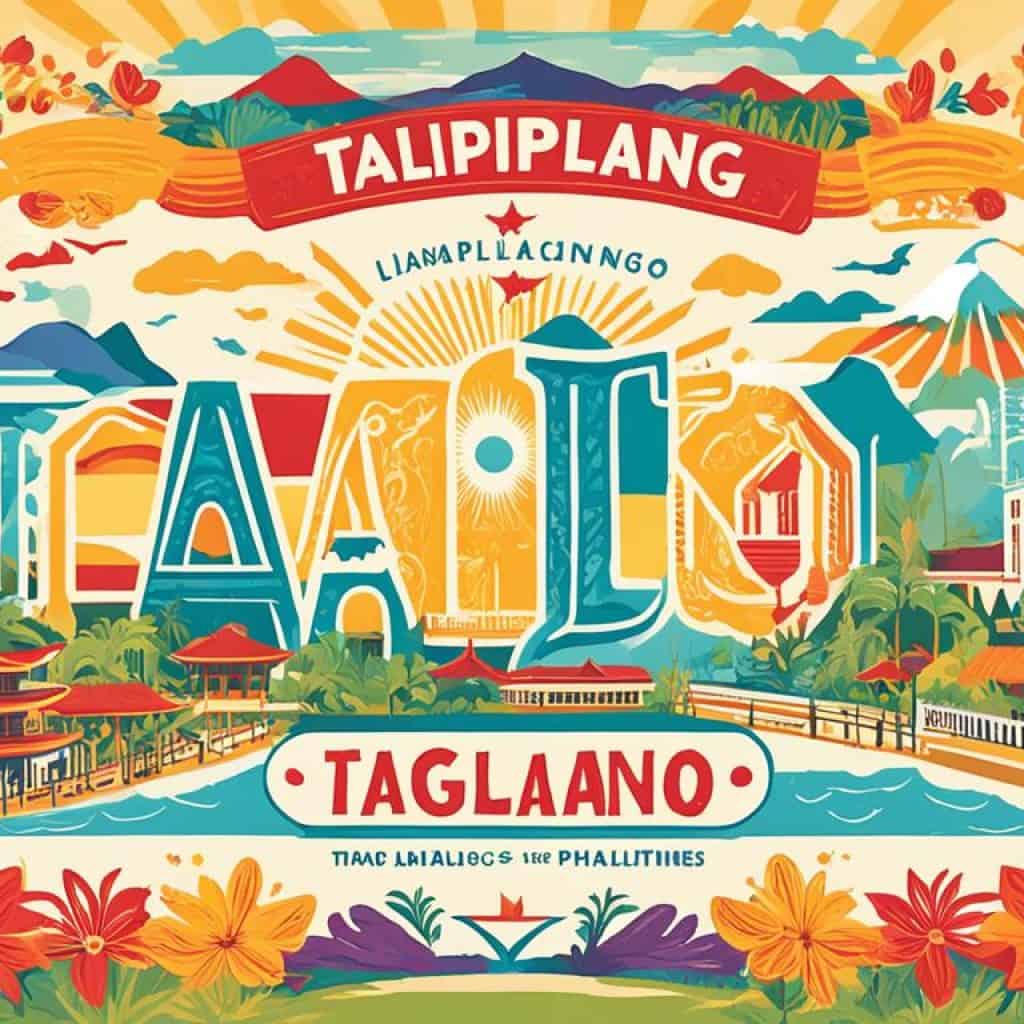Ever wondered about the Philippines’ official language? Is it Tagalog, English, or perhaps something else? Let’s dive in and discover the national language of this vibrant country. Get ready for some surprises along the way!
Key Takeaways:
- Filipino, also known as Wikang Filipino, is the national language of the Philippines.
- Filipino is a standardized variety of Tagalog, spoken by the majority of Filipinos.
- The Philippines is a linguistically diverse country with over 175 living languages.
- Spanish was the sole official language during the Spanish colonization period.
- Tagalog is one of the most widely spoken languages in the world.
Linguistic Diversity in the Philippines
The Philippines is home to a wide variety of languages. These languages are spoken by different groups across the country. Over 175 living languages exist in the archipelago, showing the country’s rich diversity.
Many languages in the Philippines come from the Austronesian family. This family includes languages across Southeast Asia, the Pacific, and mainland Asia. The Austronesian migration from Taiwan influences these languages, linking them together.
Indigenous languages in the Philippines have a special role. They’ve been spoken by various communities for centuries. These languages, like Cebuano, Ilocano, and Hiligaynon, keep rich traditions alive.
| Language | Number of Speakers | Region |
|---|---|---|
| Cebuano | ~21 million | Central Visayas, Mindanao |
| Ilocano | ~8 million | Ilocos Region, Cordillera Administrative Region |
| Hiligaynon | ~9 million | Western Visayas |
| Waray-Waray | ~3 million | Eastern Visayas, Samar |
| Bicolano | ~5 million | Bicol Region |
| Kapampangan | ~2 million | Pampanga, Central Luzon |
Philippines’ languages show its cultural wealth. They remind us of the diverse communities in this archipelago. These languages not only aid in communication but also give insights into Filipino history, traditions, and identities.
Filipino vs. Tagalog
Filipino and Tagalog are close yet distinct languages in the Philippines. Each has unique features and roles.
Filipino language
Filipino, the Philippines’ official language, is rooted in Tagalog. Tagalog is mainly spoken in Metro Manila and urban areas. Filipino was developed to unite Filipinos across different regions and linguistics.
Today, Filipino is key in education, media, and government. It is the instruction language in schools, making education accessible to all. It’s vital in the media, with movies and TV shows in Filipino. It’s also used in official documents and government communication.
Tagalog language
Tagalog is the native dialect of Metro Manila and nearby places. It’s used casually and in everyday chats. Despite not being the national language, Tagalog is crucial to Filipino identity and heritage.
While both languages are similar, Filipino is more inclusive. It borrows from other Philippine languages and dialects. This makes Filipino representative of the country’s diverse culture.
Tagalog, however, keeps traditional aspects. It reflects the unique culture and history of the Metro Manila area. It connects Filipinos to their roots and traditions.
Richness and Diversity
Filipino and Tagalog enhance the Philippines’ linguistic diversity. They help Filipinos express their thoughts and feelings. These languages are key to the country’s cultural identity, showcasing its vibrant diversity.
| Category | Filipino | Tagalog |
|---|---|---|
| Official Language | Yes | No |
| Regional Focus | Philippines | Metro Manila |
| Language Variation | Standardized and inclusive | Traditional and localized |
| Usage | Education, media, government | Colloquial conversations |
| Influence | Regional dialects, other Philippine languages | Metro Manila region |
Filipino and Tagalog both shape the Philippines’ linguistic scene. Filipinos use them to express themselves and connect with their heritage. Filipino is the national language, but Tagalog boasts a unique regional flavor. Together, they highlight the language diversity in the Philippines.
History of Spanish in the Philippines
Spanish became important in the Philippines from the late 16th century to 1898. It was the main language for government, trade, education, and arts. This lasting influence deeply impacted the country’s culture and history.
Under Spanish control, the Spanish language helped the government talk with Filipino people. It shaped the way things were run and laws were made. And, it was essential in schools for teaching many subjects.
Spanish also thrived in the arts and literature. Famous Filipino intellectuals and writers, like José Rizal, wrote in Spanish. They shared their thoughts and pushed for changes in society using the language.
When the U.S. took over in 1898, English started to be used along with Spanish. But over time, English became more dominant in government and schools.
Even as its official use dropped, Spanish still touched Filipino culture deeply. Spanish words stayed in the Filipino language, showing the two languages’ historical ties. Spanish also influenced Filipino music, food, and religion, adding to the country’s cultural richness.
Now, Spanish isn’t spoken much in daily life in the Philippines. Yet, its influence is a strong part of the country’s colonial past. The Spanish language marks a key period in the Philippines’ cultural history, showing the rich mix of languages that define its identity.
Spanish in the Philippines Today
Spanish is not common in the Philippines now, but about 400,000 people still speak it. This small community of Spanish speakers keeps the language alive.
“Spanish has a historical and cultural influence in the Philippines that is still recognized today.”
The Academia Filipina de la Lengua Española is key to keeping Spanish alive. It works with the Asociación de Academias de la Lengua Española to oversee the Spanish language globally.
In the Philippines, you might find Spanish-speaking areas. These communities have kept the language through generations. Spanish-language media and schools also help celebrate Spanish heritage.

Spanish in the Philippines reminds us of the country’s colonial history and diverse culture. Although not as widespread, Spanish still influences the Philippines today.
| Spanish in the Philippines | Spanish Speakers in the Philippines |
|---|---|
| Spanish has a historical and cultural influence in the Philippines. | Approximately 400,000 individuals still speak Spanish in the country. |
| The Academia Filipina de la Lengua Española is the main Spanish-language regulating body in the Philippines. | Spanish-speaking communities can be found in various areas of the country. |
| Spanish-language newspapers, radio stations, and educational institutions play a role in the preservation of Spanish. | The Spanish language serves as a reminder of the Philippines’ colonial past. |
Influence of Other Languages on Tagalog
Tagalog, the Philippines’ national language, has evolved through interactions with other nations. These interactions have introduced new words and phrases to Tagalog. Thus, making its vocabulary and expressions unique today.
English Influence on Tagalog:
The English language has deeply influenced Tagalog. Many English words and phrases have been adopted. This happened during the American colonization era. Back then, English became an official language in the Philippines. Words related to technology, education, and pop culture from English are now common in Tagalog.
Spanish Influence on Tagalog:
Spanish has also played a big role in shaping Tagalog. It was the Philippine language during Spanish rule. Tagalog borrowed many words from Spanish. Religious terms, food names, and surnames in Tagalog often come from Spanish.
The mixing of Tagalog and English is called Taglish. Taglish is a mix used by Filipinos every day. They combine words and phrases from both languages smoothly.
| English Influence on Tagalog | Spanish Influence on Tagalog |
|---|---|
|
|
The influences of English and Spanish have made Tagalog richer. They show the Philippines’ diverse cultural history.
Importance of Tagalog
Tagalog is not just a language; it’s a bridge for over 50 million speakers in the Philippines. And it connects around 24 million speakers worldwide. This makes it key in linking Filipinos everywhere.
It holds deep cultural significance. Tagalog allows Filipinos to express their identity and heritage. It fosters a sense of unity and shared history among them.
“Tagalog is more than just a language; it’s a gateway to the Filipino identity and serves as a bridge between generations, preserving our history and traditions.”
Tagalog helps Filipinos share their stories and values. It enables them to express their emotions and thoughts in a unique way. This strengthens cultural understanding and appreciation.
Tagalog is crucial in preserving the Philippines’ diverse languages. As an official language, it represents the country’s history and linguistic evolution. This highlights the Filipino people’s journey.
In our global village, Tagalog’s importance shines even brighter. It links Filipinos abroad, creating a sense of belonging. This connection is vital in a connected world.
Tagalog’s Role in Education and Media
In education, Tagalog is key. It’s used in schools across the Philippines. This promotes literacy and knowledge among students.
The media also boosts Tagalog’s presence. Television, movies, and music in Tagalog help the language grow. It adapts to speaker needs and interests.
The Significance of Tagalog in Business and Tourism
Tagalog is valuable in business and tourism too. Knowing Tagalog improves communication with Filipinos. It also offers tourists a richer experience of the Filipino culture.
In the United States, Tagalog’s impact is clear. It’s the third most spoken non-English language. This shows its global importance, from California to Washington.
| Tagalog in the Philippines | Tagalog Worldwide |
|---|---|
| Over 50 million speakers | Around 24 million speakers |
| Serves as a communication tool for Filipinos | Connects the Filipino diaspora |
| Preserves the cultural heritage of the Philippines | Fosters understanding of Filipino culture |
| Plays a vital role in education and media | Utilized in business and tourism |
Tagalog in the United States
Tagalog, the official language of the Philippines, is also spoken in the United States. Many Tagalog speakers live in states like California, Nevada, and Washington. This makes it the third most common non-English language in the country.
California is a key place for Tagalog speakers because of its large Filipino-American community. In cities such as Los Angeles, San Francisco, and San Diego, Tagalog fills the air. You can hear it in houses, businesses, and at cultural gatherings.
In Nevada, the Las Vegas area is prominent for Tagalog speakers. The entertainment and hospitality industries there attract many Filipino immigrants. This has made Tagalog a familiar language in the area.
Washington is experiencing growth in its Tagalog-speaking population too. From Seattle to other parts of the state, Tagalog’s presence is evident. It helps Filipino-Americans stay connected and preserves their language traditions.
Well-known individuals like apl.de.ap from the Black Eyed Peas and actress Meghan Markle can speak Tagalog fluently. Their use of the language shows the strong cultural and linguistic impact Tagalog has in the U.S.
To sum up, Tagalog has established a presence in the United States, especially in California, Nevada, and Washington. The language and its speakers show the rich cultural ties Filipino-Americans have to their heritage.
Tagalog Translation
Tagalog translation is essential for connecting with Tagalog-speaking people. It’s needed for translating marketing stuff, legal documents, or website content. Clear communication depends on accurate translations.
At Dynamic Language, we’re experts in language translation, including Tagalog. Our team has over 30 years of experience. We use native-speaking translators to ensure high-quality translations. These translations reflect the Tagalog language’s cultural context.
We guarantee attention to detail in our translation process. We stick to deadlines and follow strict quality control. We know keeping your brand accurate is important. That’s why we work closely with our clients.
Need Tagalog translations for business, legal, or personal reasons? Our team can handle many projects. We translate marketing materials, product descriptions, legal contracts, and localize websites. Our work helps you reach Tagalog-speaking people effectively.
Why Choose Dynamic Language for Tagalog Translation?
- Experience: We have over thirty years of experience in translations. This has given us deep knowledge and skills.
- Native-speaking Translators: Our team includes professional translators. They are native speakers, offering accurate and appropriate translations.
- Cultural Understanding: Understanding culture is key in translation. Our translators know the Tagalog language and Filipino culture well.
- Quality Control: Our strict quality control means accurate, error-free translations. You can trust us to reach your Tagalog-speaking audience.
- Wide Range of Services: We provide many services. This includes document translation, website localization, interpretation, and more.
Choose Dynamic Language for Tagalog translation needs. Experience professional and reliable services. We’re committed to helping you reach your audience. We provide accurate and culturally sensitive translations.
Linguistic Significance of Tagalog
Tagalog is more than just a way to talk. It is historically rich and part of the Austronesian language family. Studying and keeping this language alive helps us understand how languages and cultures evolve in the Philippines.
Tagalog has changed over time, mixing with different languages and cultures. It started with Proto-Philippine and Old Tagalog roots. The Philippines’ connections with other countries, especially Spain, changed Tagalog. These changes reflect the country’s history and how its people live today.
Tagalog literature and cultural expressions show the Filipinos’ unique views and traditions. Famous Tagalog works give us a peek into the country’s past, its values, and its rich culture.
To keep Tagalog going, we work on highlighting its special features and variety. Studying Tagalog shines a light on linguistics. It helps us see how language changes and its role in forming cultural identity.
The Role of Tagalog in Language Preservation
Keeping a language alive is key to holding onto cultural heritage and identity. By saving Tagalog, we keep alive a language full of the Philippines’ linguistic and cultural history.
To keep Tagalog alive, experts document, teach, and create spaces for it to grow. Researchers study and note down its unique traits. This helps keep the language modern and relevant.
“Language is the storage of a people’s history, traditions, and values.” – Dr. Jose Reyes
Preserving Tagalog lets future Filipinos connect with their roots. It also helps them understand the role of their language in their identity. Being proud of Tagalog ensures it stays alive and well.
The Significance of Tagalog for Cultural Understanding
Tagalog acts as a bridge connecting Filipinos at home and abroad. Through this language, we keep and share our traditions and values.
The variety in Tagalog words comes from the Philippines’ history with different cultures, like English and Spanish.
Tagalog’s importance reaches beyond the Philippines. It offers insights into how languages mix and change and highlights the link between language and culture. Studying Tagalog helps us understand Southeast Asian languages and their roots in the Austronesian family.
| Benefits of Tagalog Language Preservation | Examples |
|---|---|
| Preserving cultural heritage | Preserving traditional folk songs and oral narratives |
| Enhancing intercultural understanding | Promoting dialogue and cultural exchange |
| Fostering a sense of identity | Preserving ancestral traditions and values |
| Promoting linguistic diversity | Encouraging multilingualism and language learning |
The Future of Tagalog
The significance of Tagalog continues to shape its future. Efforts to keep the language going, educational programs, and new technologies offer chances to share and learn Tagalog around the world.

Recognizing the value of Tagalog helps it develop. By cherishing and embracing Tagalog, we safeguard its place in the future for coming generations.
The Evolution of Tagalog
Tagalog, the national language of the Philippines, has seen many changes. It has been shaped by different languages and cultures. This evolution reflects its rich historical and sociocultural background.
The roots of Tagalog reach back to Proto-Philippine and Old Tagalog. These early forms laid the groundwork for Tagalog’s growth.
The Spanish colonial era brought Tagalog into contact with other nations. This lead to changes in vocabulary and pronunciation. Thus, Spanish loanwords mixed with native terms.
Additionally, trade and communication with countries like China, Japan, and the USA enriched Tagalog. This added new words and phrases to the language.
Today, Tagalog showcases the Philippines’ diverse linguistic heritage. It keeps evolving, absorbing new influences. This evolution highlights the nation’s historical depth and cultural variety.
Over time, Tagalog has grown by taking in parts of various languages and cultures. Its beginnings are found in Proto-Philippine and Old Tagalog. Interactions with other nations, especially during Spanish rule, changed it. These factors have crafted Tagalog’s modern form.
Knowing how Tagalog evolved is key for both language studies and understanding its cultural weight. Tagalog’s development shows the Filipino spirit of resilience, adaptability, and cultural wealth.
| Period | Characteristics |
|---|---|
| Proto-Philippine | Earliest known form of Tagalog; foundation for the development of the language |
| Old Tagalog | Early stage of Tagalog with distinct grammatical features and vocabulary |
| Spanish Colonial Period | Influx of Spanish loanwords and influences on vocabulary and pronunciation |
| Modern Era | Incorporation of vocabulary and idiomatic expressions from various languages and cultures |
Tagalog Literature and Cultural Expression
Tagalog literature is a treasured part of Filipino culture, spanning centuries of artistic expression and storytelling. It ranges from lyrical poems to thought-provoking novels and impactful plays. These works showcase the unique perspectives and cultural experiences of Filipinos.
They dive into the depths of Filipino history, traditions, and values. This gives us valuable insights into the vibrant tapestry of this nation.
Tagalog literature has evolved over time, reflecting changes in Filipino society. It shows the diverse influences encountered. Historical events, colonialism, and cultural exchanges have shaped its themes, styles, and content.
The Spanish colonial era is a notable period in Tagalog literature. Indigenous storytelling mixed with Spanish traditions created a unique body of work. Authors like Jose Rizal and Francisco Balagtas emerged, creating celebrated masterpieces.
“Literature is the mirror of society, reflecting struggles, triumphs, and aspirations. Tagalog literature captures the essence of the Filipino spirit, giving us a way to understand ourselves and our heritage.” – Dr. Alejandro Umali, literary critic
Tagalog literature not only preserves the history and traditions of the Philippines but also expresses cultural identity. Through arts and storytelling, Filipinos share their unique experiences, values, and hopes with the world.
Influential Figures in Tagalog Literature
Many influential figures have shaped Tagalog literature’s vibrant history. They’ve left a lasting impact on the literary scene.
| Author | Notable Works |
|---|---|
| Jose Rizal | Noli Me Tangere, El Filibusterismo |
| Francisco Balagtas | Florante at Laura |
| Lualhati Bautista | Dekada ’70, Bata, Bata… Pa’no Ka Ginawa? |
| Nick Joaquin | May Day Eve and Other Stories, The Woman Who Had Two Navels |
These literary giants have hugely contributed to Tagalog literature. Their works inspire writers and connect with readers globally.
- Tagalog literature helps preserve culture, letting future generations connect with their roots and values.
- These works highlight the struggles and victories of Filipinos, offering deeper insights into their history and experiences.
- It captures Filipino cultural expression, allowing unique perspectives to contribute to global literature.
Exploring Tagalog’s rich literary heritage deepens our appreciation for the diverse voices and narratives shaping Filipino identity.
Tagalog as a Source of Pride
Tagalog language and culture are deeply important to Filipinos. They see it as a source of pride. It also symbolizes their identity and heritage. This connection brings them closer to their roots and ancestors.
This bond makes them feel united and gives them a sense of belonging. The love and respect for Tagalog help keep Filipino culture alive. By using their language, Filipinos showcase their rich heritage. They also show they want to keep their unique traditions.
Tagalog reflects what it means to be Filipino. It shows the values and beliefs that guide their lives. Through Tagalog, emotions are shared, thoughts are communicated, and stories are told. This strengthens the community bond.
Tagalog unites Filipinos, no matter where they are in the world. It connects different generations. This helps pass down cultural knowledge and traditions through the years.
“Tagalog language is more than just a means of communication; it is a testament to the resilience and beauty of the Filipino people.”
There is a lot of pride in Tagalog. It motivates people to keep the language alive. Filipinos use education, books, and cultural events to celebrate Tagalog. They want it to last for generations to come.
For Filipinos living abroad, Tagalog brings them comfort. It helps them stay connected to their roots. This way, they can keep their cultural identity. Even in new places, they celebrate their Filipino heritage with pride.
Tagalog shows the resilience, creativity, and complexity of Filipino culture. It represents the different lives and views of the Filipino people. This makes it a key part of the world’s languages and cultures.
Tagalog Expressions
- Madali pala.
- Mabuhay!
- Tawa naman tayo!
Conclusion
Tagalog is the national language of the Philippines, deeply woven into Filipino culture. It holds immense historical importance. This language keeps Filipinos connected to their heritage and ancestors.
In the diverse linguistic scene of the Philippines, Tagalog unites the people. It’s a source of national pride. Through literature, art, and daily talk, Filipinos celebrate and keep their culture alive.
Tagalog is crucial in defining Filipino identity. As the national language, it brings unity and understanding. It symbolizes the Filipino spirit and their shared journey.







Add comment